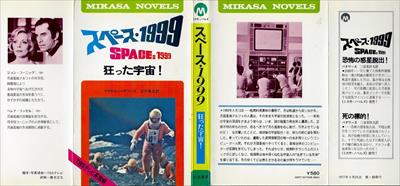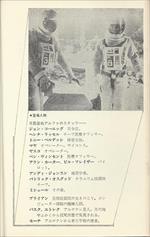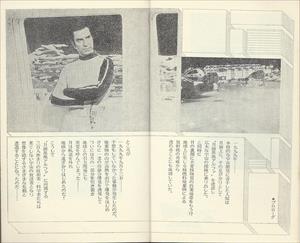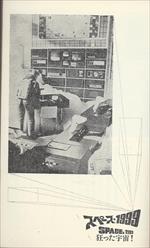Novelisations
Mikasa, Japan
Compiled by Martin Willey
Mikasa Novels published three novels based on Year 2, translated from the Michael Butterworth titles. Overview
Mikasa Novels 25 May 1977. 220 pages.
0297-007005-8001
Translated by Keishi Masaki from Mindbreaks Of Space (Does not include One Moment Of Humanity)

These books use the traditional Japanese orientation, reading from right to left, with the spine on the right. Each book starts with a six pages of introduction and photos, shown here.




1999
Mankind has accomplished full-scale development on the Moon, constructing "Moonbase Alpha", and is embarking on a vast exploration of the universe.
At the same time, mankind has succeeded in avoiding the radioactivity caused by the nuclear fuel waste on the Earth by creating a dumping zone for the unnecessary nuclear material on the back side of the Moon.
However September 13, 1999
An unexpected situation occurs. A mountain of waste heats up to a high temperature and explodes, inducing a further series of nuclear-powered explosions, finally tearing the Moon from the gravitational influence of the Earth --- The Moon is thrown out of orbit and begins to move away from the Earth!
And now "Moonbase Alpha", with its three hundred plus engineers and technicians�Scientists who will encounter unimaginable dangers while on an endless journey of the universe...
Moonbase Alpha staff
Three years after leaving the Earth - A drifting object in a unique setting
September 13, 1999 - when I look at this sequence of numbers, it makes me smile. Do you know Osamu Tezuka'sTezuka (1928-1989) is often known as the "father of Manga", hugely influential in post-war Japanese comics and animation. He created Astro Boy (1952+), Princess Knight (1953+) and Black Jack (1973+) epic science fiction manga "Lost WorldTwo volume manga series, 1948, known for introducing steampunk elements"? The Mamango star, a brother to the moon, is said to have been torn away from the Earth during ancient times, it draws an extremely elongated elliptical orbit and returns close to the Earth... on April 4, XX, 13:13:13. After various great adventures, staring a future Adam and Eve, the star Mamango will depart from the vicinity of the Earth again... In Space 1999, the Moon will also move away from Mother Earth in the date mentioned at the beginning. The strange similarities in those numbers makes me feel like a child again, and make me quite happy. However, if I looked up at the night sky and could never see the Moon again, it would feel a little lonely.
And right from the beginning (similar to the fate of the Moon in this series of space adventure stories) I have become derailed; but this idea, which is the prologue of the whole series, I can say is truly outstanding. When it comes to serialized hard science fiction TV dramas, even after the production has stopped and the broadcasting ended, there will inevitably be a movement to request a re-broadcast of the show, and for the creation of spacecraft blueprints and various detailed design drawings. That "Space Strategy"[Star Trek], would be the obvious association with this. (Similarly, a famous science fiction writerJames Blish has written the novelizations, and there are Japanese translations as well.)
It can be said that the Odyssey after Moonbase Alpha has left Earth orbit is essentially the same as the grand tour of the Patrol Ship Enterprise in "Space Strategy". It's an omnibus-style of storytelling, where it is always focused on the where and what of the incident that is encountered, and is the key to the method of these endless stories. However, in this show, they can never return to the Earth, they don't know when the nuclear fuel will be replenished, they want to quickly find a second home, a safe place to live... This sense of urgency puts more attention to the development of the story, adds another layer, and its strength is to increase the fictional reality.
For example, the idea of hollowing out an asteroid, setting up a city inside, installing an engine, and making it a full spaceship has been around for a long time, but Moonbase Alpha is a spaceship that can not be kept manoeuvring. That's why, as mentioned in the episode, since it is difficult to find a nuclear energy source and the underground is being steadily developed, and if this TV series lasts for 10 years, (it's currently three years in), over time it will became a spaceship, Koenig II will take command, and return to the Earth... that time may come. By the way, the show is a setting where there is one alien within the main character group, and it's not as if there's any mystery to its parallel with "Space Strategy". As well, I can't help but pray for a similar legendary popularity.
By the way, this "Crazy Universe!" is supposed to occur in the third year after leaving the Earth, but that is only the time on board the base, and it is impossible to know what time it is on Earth without bringing up the special theory of relativity, let alone dimensional warps. Moonbase Alpha is always falling into things, so it appears that they are on a blind flight. The original title was Mind Breaks of Space (1977), and is composed entirely of minds that have been broken, a crazed humanoid computer, a crazed alien, and a crazed base member, where each episode brings a crisis to Moonbase Alpha. It unexpectedly resembled Frederic Brown's masterpiece "What Mad Universehumorous 1949 parallel universe novel", but I don't believe I read that novel by mistake.
Of note, there is a prop called a "COMMLOCK" used without any explanation in the text, but if you are watching the show on TV, it is a communicator with a mini screen and other essential items with various uses for base personnel. I have a guess that it is a compound word based on communication and lock.
Another is the transfer tube. On TV, it's like a cylindrical subway car running through a large tunnel that extends, in a bellows-like manner, to connect them to the spacecraft airlock, but in the original book it was simply called a travel tube. With this style of writing, without any association to actual images, it's annoying to not have an explanation for anything. In foreign novels, even in general fiction books, it seems that product names will be employed without any explanation to what it refers, and you may become angry, but in the end everything seems to work out just right.
I really wanted to write about things like the relationship between science fiction and video culture, but I couldn't handle it due to a lack of study. Movies and science fiction, television and science fiction, chronologically, the transitions of their formative years and the golden age seem to run in parallel, and there is realism, our 'reality', and an immediacy at one end of the spectrum, and at the opposite end, as can be seen in science fiction, there's a spirit of creating a magnificent imaginary landscape that tries to make what is fiction look real, I'll just mention that it might be concurrent with that transition - if there is an opportunity again.
(77.4.23, M K C)
Thanks to Patrick Zimmerman